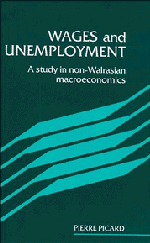Book contents
- Frontmatter
- Contents
- Acknowledgements
- Introduction
- 1 Price rigidities and temporary equilibrium
- 2 Wage rigidity and short-run macroeconomic equilibrium
- 3 Real wages and the inflation—unemployment dilemma
- 4 External constraint, oil shock and economic policy
- 5 Implicit contracts and unions
- 6 Introduction to efficiency wage models
- 7 Efficiency wages, employment fluctuations and fiscal policy
- 8 Labour market dualism, efficiency wages and optimal taxation
- Notes
- References
- Author index
- Subject index
5 - Implicit contracts and unions
Published online by Cambridge University Press: 28 October 2009
- Frontmatter
- Contents
- Acknowledgements
- Introduction
- 1 Price rigidities and temporary equilibrium
- 2 Wage rigidity and short-run macroeconomic equilibrium
- 3 Real wages and the inflation—unemployment dilemma
- 4 External constraint, oil shock and economic policy
- 5 Implicit contracts and unions
- 6 Introduction to efficiency wage models
- 7 Efficiency wages, employment fluctuations and fiscal policy
- 8 Labour market dualism, efficiency wages and optimal taxation
- Notes
- References
- Author index
- Subject index
Summary
Our main concern in chapters 5 and 6 is to analyse why real wages may be downward rigid, while some degree of involuntary unemployment prevails in the economy. Two possible explanations are explored in this chapter, implicit contracts and unions, while the third, efficiency wages, is the subject of chapter 6.
The theory of implicit contracts is based on the assumption that wages and employment result from long-term agreements between firms and their employees. Such agreements allow them to share out risk that might affect the profitability of the firms. In this framework, firms are able to provide insurance against uncertainty to their employees and this may lead to some degree of real wage rigidity.
We may introduce the notion of long-term implicit contract as follows. Consider two successive periods 0 and 1. Workers who are actually productive in period 1 were hired in period 0 because for instance training on the job was necessary. In period 0, workers and firms sign contracts specifying their respective obligations in different situations that might occur in period 1. If we assume that an individual can provide an indivisible unit of labour, a contract will define a wage, a level of unemployment benefit and the number of individuals actually employed by the firm for every state of nature in period 1.
- Type
- Chapter
- Information
- Wages and UnemploymentA Study in Non-Walrasian Macroeconomics, pp. 143 - 175Publisher: Cambridge University PressPrint publication year: 1993



